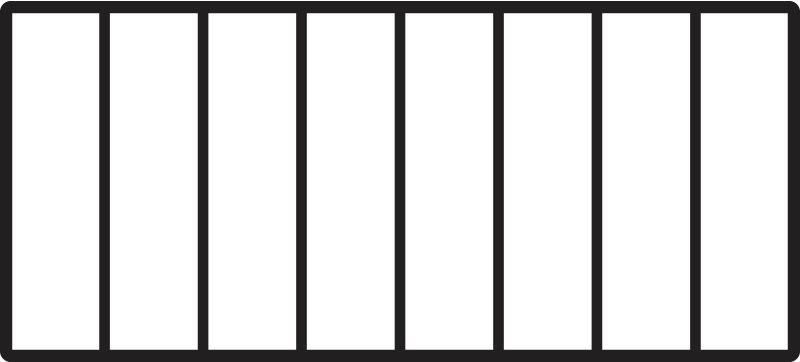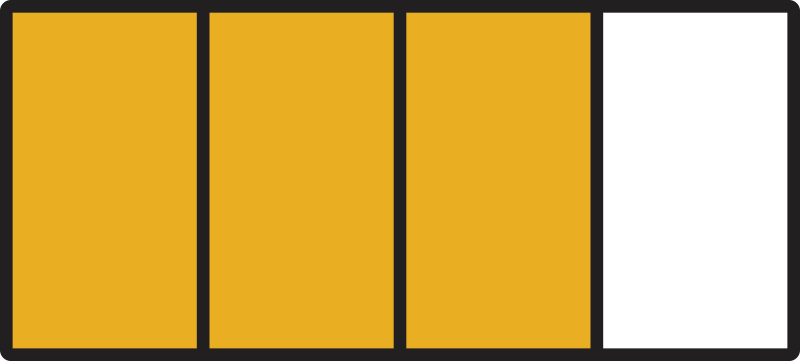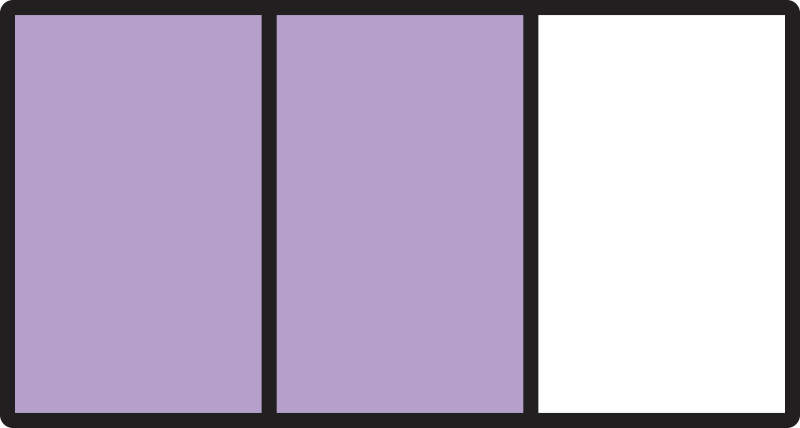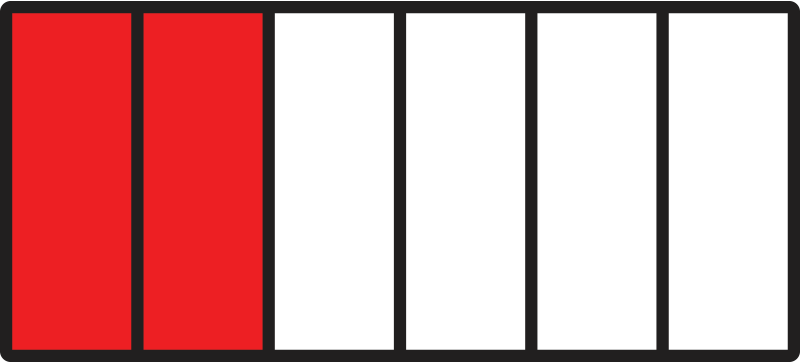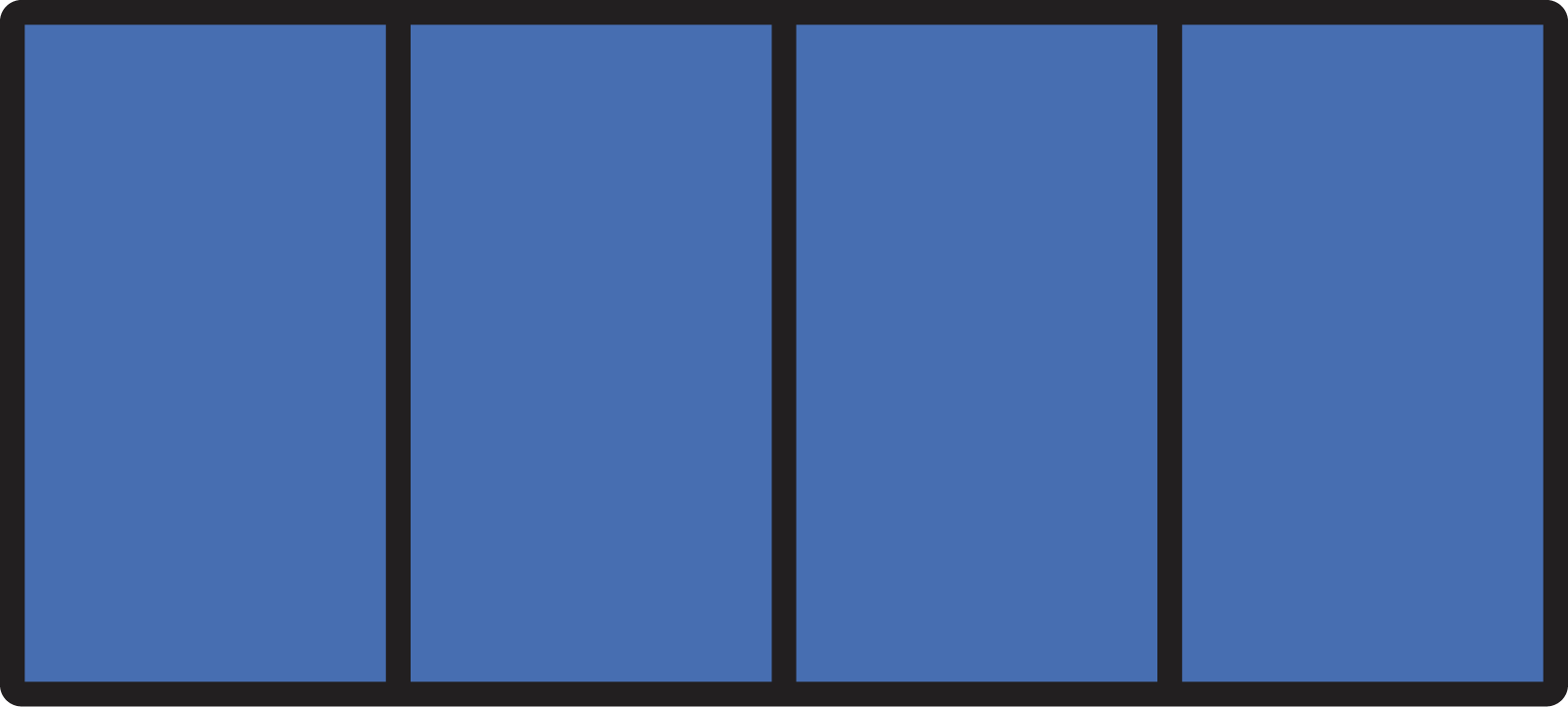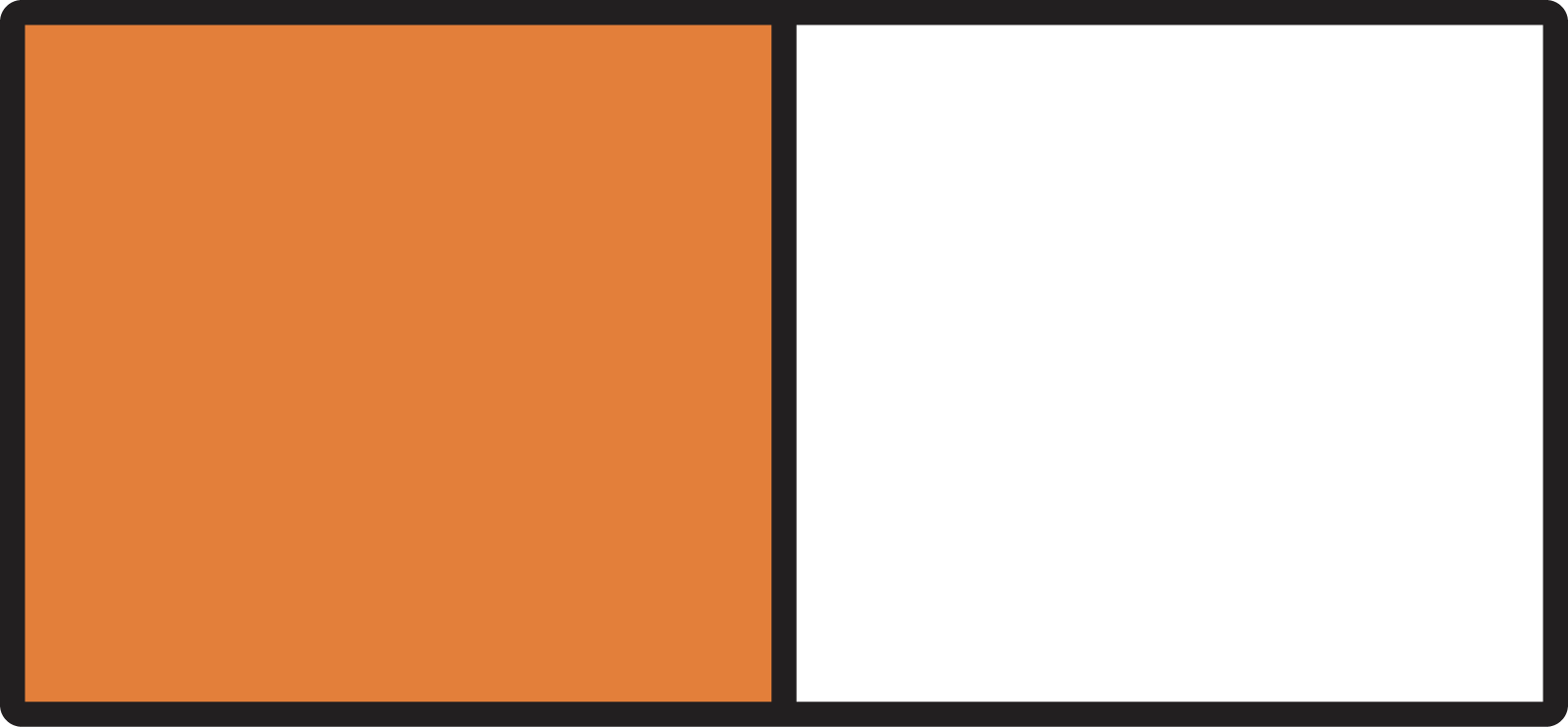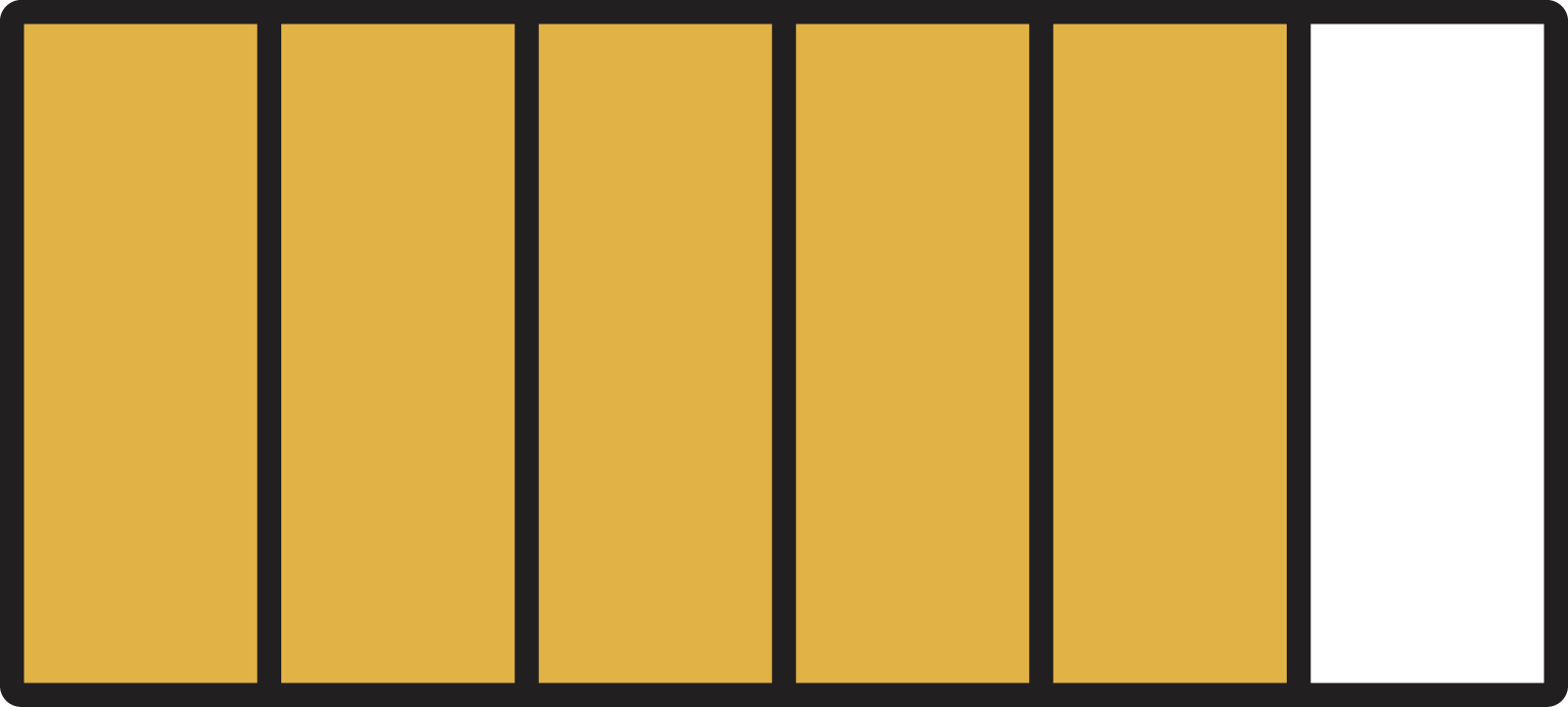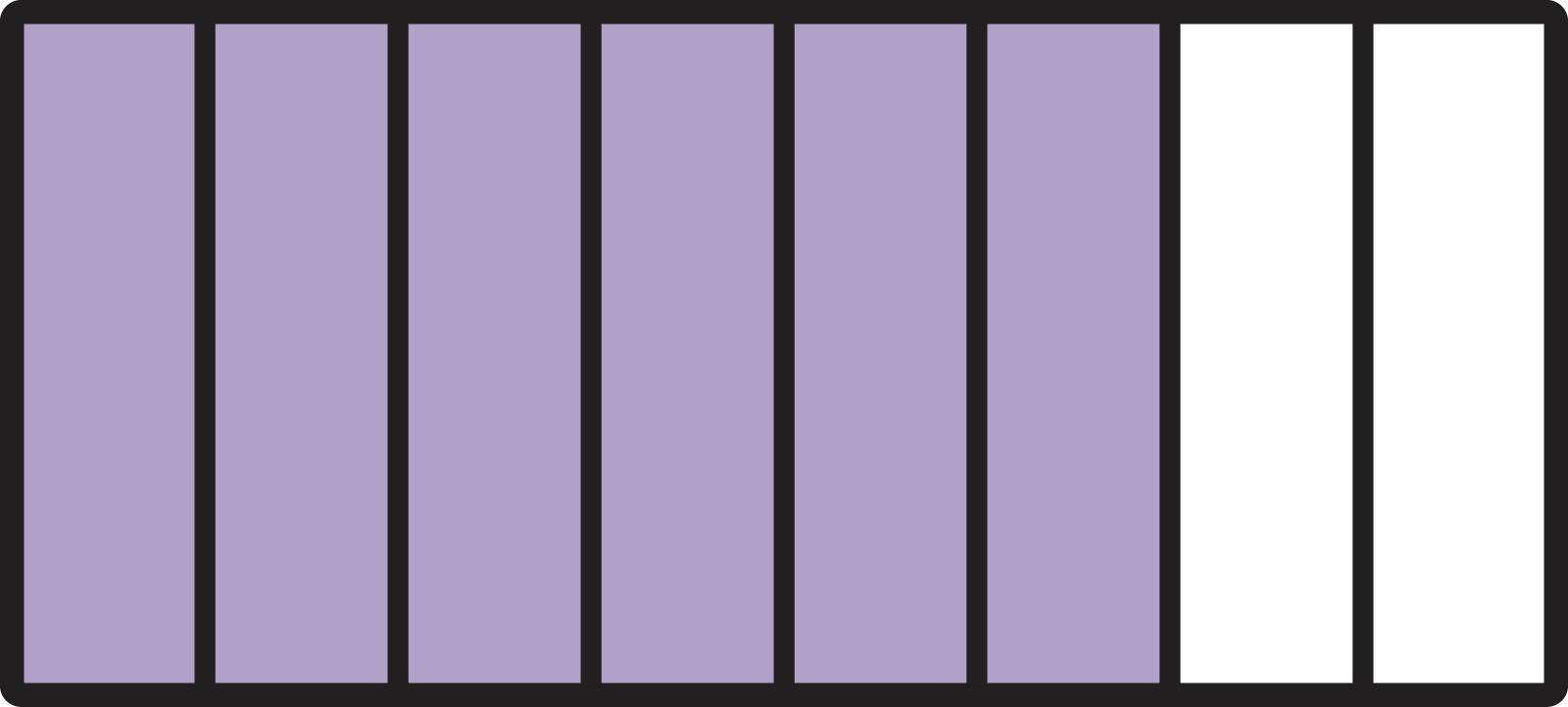Assess Yourself
How well do you understand the ideas in this lesson?
Goal:
Goal:
Are you ready to take this lesson's quiz? These questions will help you find out. Go back to the lesson if you do not know an answer.
Which fraction is equivalent to \({ \frac{1}{2} }\)?

Number line from 0 to 1 with 3 markers. Marks are labeled from \({ \frac{0}{2} }\) to \({ \frac{2}{2} }\). Dot above \({ \frac{1}{2} }\).
-

Number line from 0 to 1 with 9 markers. Marks are labeled from \({ \frac{0}{X} }\) to \({ \frac{X}{X} }\). Dot above \({ \frac{5}{X} }\).
-

Number line from 0 to 1 with 5 markers. Marks are labeled from \({ \frac{0}{4} }\) to \({ \frac{4}{4} }\). Dot above \({ \frac{2}{4} }\).
-

Number line from 0 to 1 with 7 markers. Marks are labeled from \({ \frac{0}{6} }\) to \({ \frac{6}{6} }\). Dot above \({ \frac{0}{6} }\).
-

Number line from 0 to 1 with 4 markers. Marks are labeled from \({ \frac{0}{4} }\) to \({ \frac{4}{4} }\). Dot above \({ \frac{2}{3} }\).
Sorry, that is not correct. The dot on this number line does not line up with \({ \frac{1}{2} }\).
Yes! \({ \frac{2}{4} }\) is equivalent to \({ \frac{1}{2} }\) because the dots line up on both number lines.
Sorry, that is not correct. The dot on this number line does not line up with \({ \frac{1}{2} }\).
Sorry, that is not correct. The dot on this number line does not line up with \({ \frac{1}{2} }\).
What are the equivalent fractions for these two shapes?

Left: Rectangle paritioned into 4 equal parts with 3 filled. Equals. Right: Rectangle partitioned into 8 equal parts with 6 filled in.
-
\({ \frac{4}{4} }\) \({ = }\) \({ \frac{1}{8} }\)
-
\({ \frac{2}{3} }\) \({ = }\) \({ \frac{4}{8} }\)
-
\({ \frac{0}{2} }\) \({ = }\) \({ \frac{1}{6} }\)
-
\({ \frac{3}{4} }\) \({ = }\) \({ \frac{6}{8} }\)
Sorry, that is not correct. These shapes show that \({ \frac{3}{4} }\) is equivalent to \({ \frac{6}{8} }\).
Sorry, that is not correct. These shapes show that \({ \frac{3}{4} }\) is equivalent to \({ \frac{6}{8} }\).
Sorry, that is not correct. These shapes show that \({ \frac{3}{4} }\) is equivalent to \({ \frac{6}{8} }\).
Yes! \({ \frac{3}{4} }\) is equivalent to \({ \frac{6}{8} }\) .
Which shape shows a shaded part equivalent to this one?

Correct! This shape shows an equivalent part shaded because neither shape has any shading.
Sorry, that is not correct. This shape has 2 parts shaded.
Sorry, that is not correct. This shape has 2 parts shaded.
Sorry, that is not correct. This shape has 2 parts shaded.
Which set of fractions are equivalent?
-
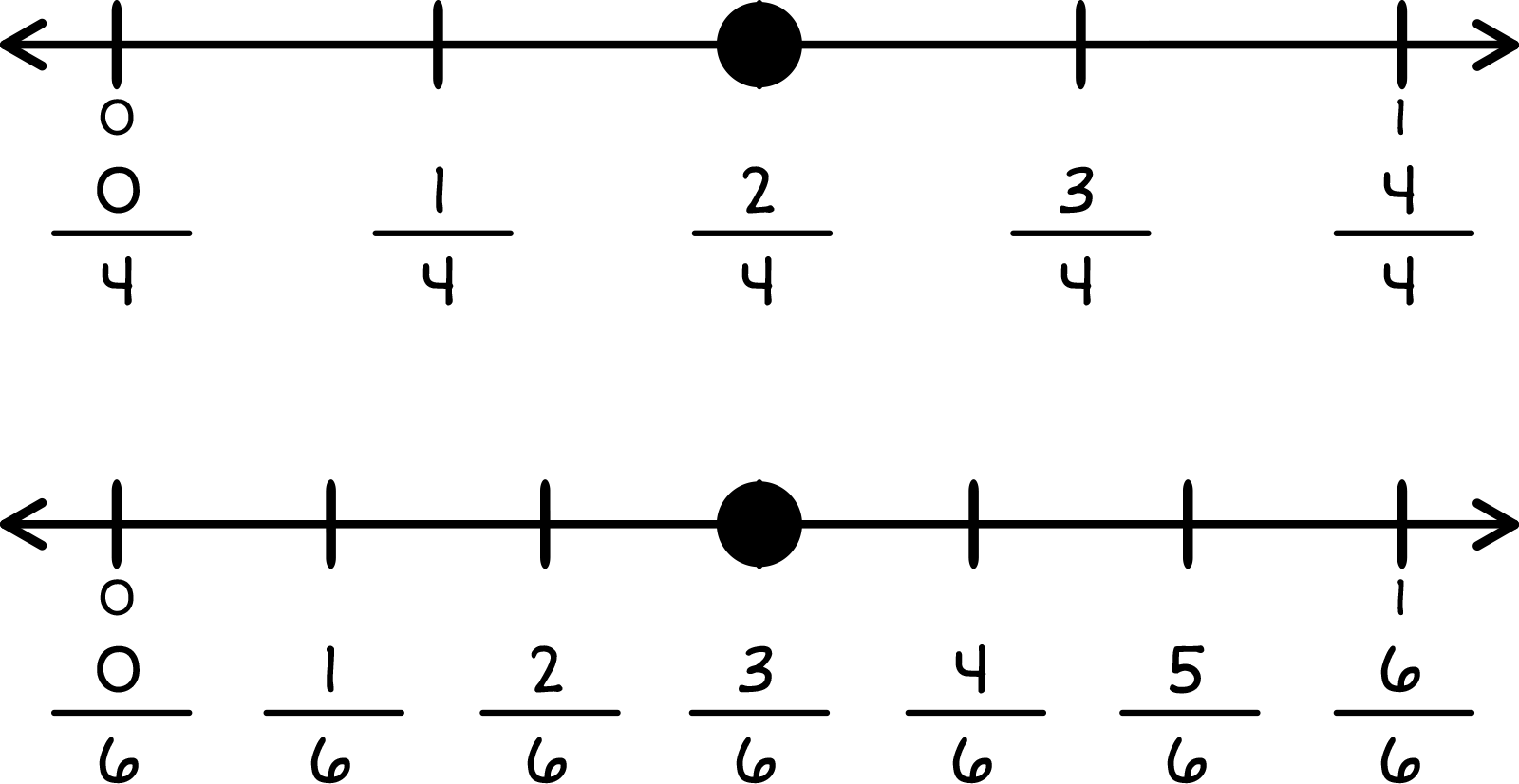
Top: Number line from 0 to 1 with 5 markers. Marks are labeled from \({ \frac{0}{4} }\) to \({ \frac{4}{4} }\). Dot above \({ \frac{3}{4} }\).
Bottom: Number line from 0 to 1 with 7 markers. Marks are labeled from \({ \frac{0}{6} }\) to \({ \frac{6}{6} }\). Dot above \({ \frac{3}{6} }\).
-
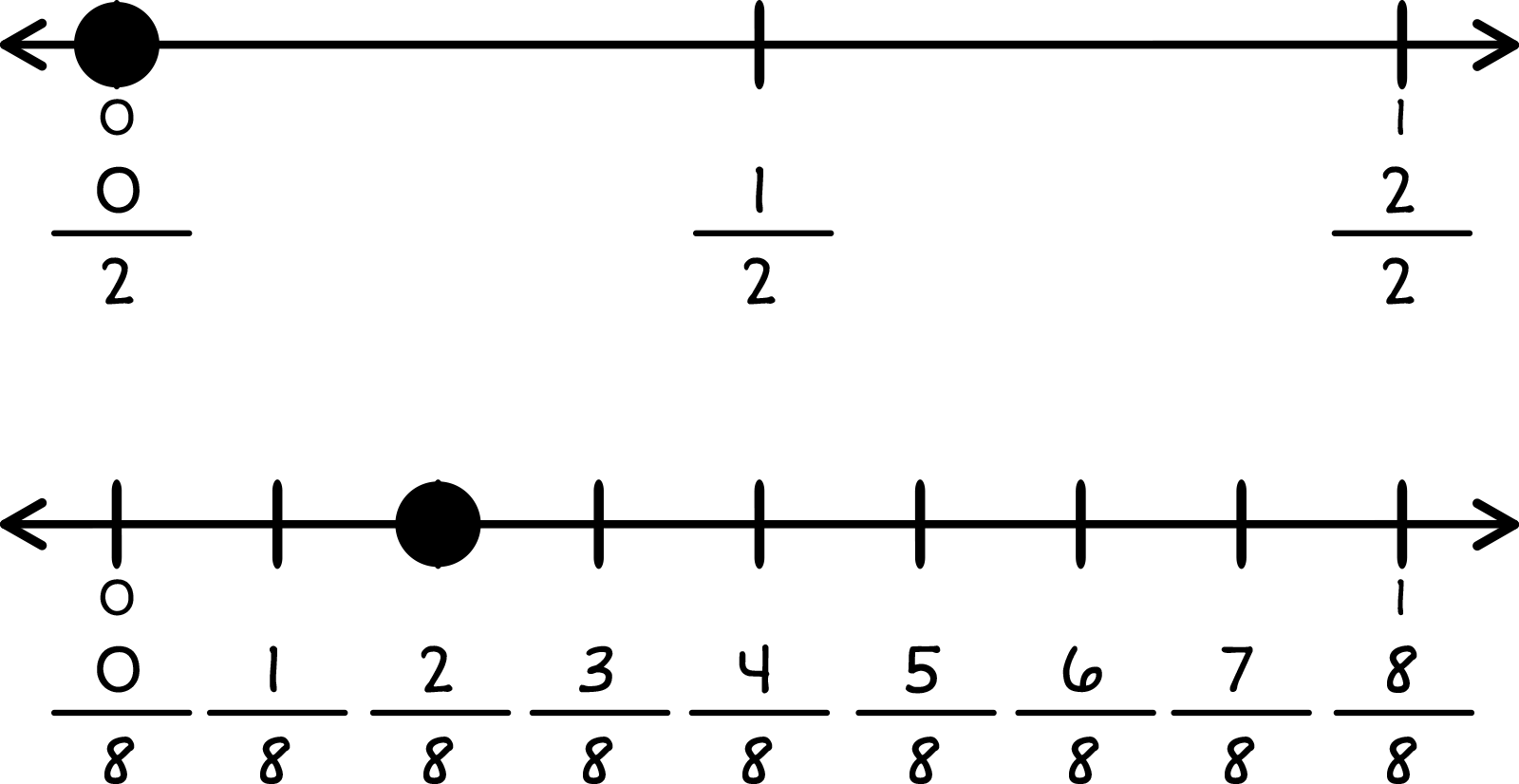
Top: Number line from 0 to 1 with 3 markers. Marks are labeled from \({ \frac{0}{2} }\) to \({ \frac{2}{2} }\). Dot above \({ \frac{0}{2} }\).
Bottom: Number line from 0 to 1 with 9 markers. Marks are labeled from \({ \frac{0}{8} }\) to \({ \frac{8}{8} }\). Dot above \({ \frac{2}{8} }\).
-

Top: Number line from 0 to 1 with 5 markers. Marks are labeled from \({ \frac{0}{4} }\) to \({ \frac{4}{4} }\). Dot above \({ \frac{4}{4} }\).
Bottom: Number line from 0 to 1 with 4 markers. Marks are labeled from \({ \frac{0}{3} }\) to \({ \frac{3}{3} }\). Dot above \({ \frac{2}{3} }\).
-
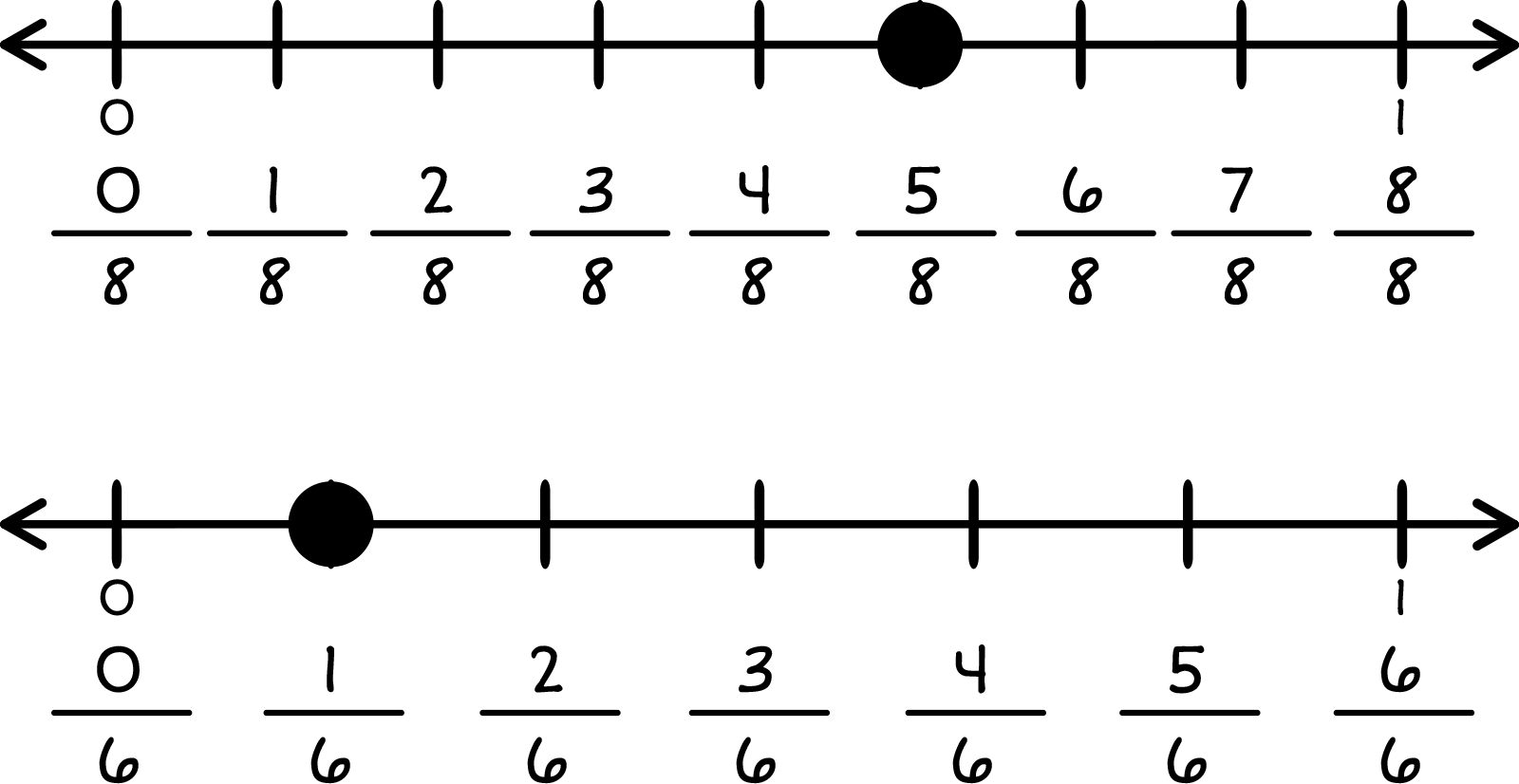
Top: Number line from 0 to 1 with 9 markers. Marks are labeled from \({ \frac{0}{8} }\) to \({ \frac{8}{8} }\). Dot above \({ \frac{5}{8} }\).
Bottom: Number line from 0 to 1 with 7 markers. Marks are labeled from \({ \frac{0}{6} }\) to \({ \frac{6}{6} }\). Dot above \({ \frac{1}{6} }\).
Yes! \({ \frac{2}{4} }\) and \({ \frac{3}{6} }\) are equivalent fractions because the dots line up on the number lines.
Sorry, these fractions are not equivalent because the dots do not line up on the number lines.
Sorry, these fractions are not equivalent because the dots do not line up on the number lines.
Sorry, these fractions are not equivalent because the dots do not line up on the number lines.
Which fraction is equivalent to \({ \frac{4}{4} }\)?

Number line from 0 to 1 with 5 markers. Marks are labeled from \({ \frac{0}{4} }\) to \({ \frac{4}{4} }\). Dot above \({ \frac{4}{4} }\).
-

Number line from 0 to 1 with 3 markers. Marks are labeled from \({ \frac{0}{2} }\) to \({ \frac{2}{2} }\). Dot above \({ \frac{1}{2} }\).
-

Number line from 0 to 1 with 4 markers. Marks are labeled from \({ \frac{0}{3} }\) to \({ \frac{3}{3} }\). Dot above \({ \frac{1}{3} }\).
-

Number line from 0 to 1 with 9 markers. Marks are labeled from \({ \frac{0}{8} }\) to \({ \frac{8}{8} }\). Dot above \({ \frac{8}{8} }\).
-

Number line from 0 to 1 with 7 markers. Marks are labeled from \({ \frac{0}{6} }\) to \({ \frac{6}{6} }\). Dot above \({ \frac{4}{6} }\).
Sorry, that is not correct. The dot on this number line does not line up with \({ \frac{4}{4} }\).
Sorry, that is not correct. The dot on this number line does not line up with \({ \frac{4}{4} }\).
Yes! \({ \frac{8}{8} }\) is equivalent to \({ \frac{4}{4} }\) because the dots on both number lines line up.
Sorry, that is not correct. The dot on this number line does not line up with \({ \frac{4}{4} }\).
What are the equivalent fractions for the shaded parts?

Left: Rectangle partitioned into 3 equal parts with 1 filled in. Equals. Right: Rectangle partitioned into 6 equal parts with 2 filled in.
-
\({ \frac{3}{6} }\) \({ = }\) \({ \frac{0}{8} }\)
-
\({ \frac{1}{4} }\) \({ = }\) \({ \frac{0}{2} }\)
-
\({ \frac{5}{8} }\) \({ = }\) \({ \frac{6}{6} }\)
-
\({ \frac{1}{3} }\) \({ = }\) \({ \frac{2}{6} }\)
Sorry, that is not correct. These shapes show that \({ \frac{1}{3} }\) is equivalent to \({ \frac{2}{6} }\).
Sorry, that is not correct. These shapes show that \({ \frac{1}{3} }\) is equivalent to \({ \frac{2}{6} }\).
Sorry, that is not correct. These shapes show that \({ \frac{1}{3} }\) is equivalent to \({ \frac{2}{6} }\).
Yes! These shapes show that \({ \frac{1}{3} }\) is equivalent to \({ \frac{2}{6} }\).
Which shape is shaded to show a fraction equivalent to \({ \frac{3}{6} }\)?

Sorry, that is not correct. The shaded parts are not equivalent.
Correct! This shape is equivalent because \({ \frac{1}{2} }\) shaded is equivalent to \({ \frac{3}{6} }\) shaded.
Sorry, that is not correct. The shaded parts are not equivalent.
Sorry, that is not correct. The shaded parts are not equivalent.
Which set of fractions are equivalent?
-
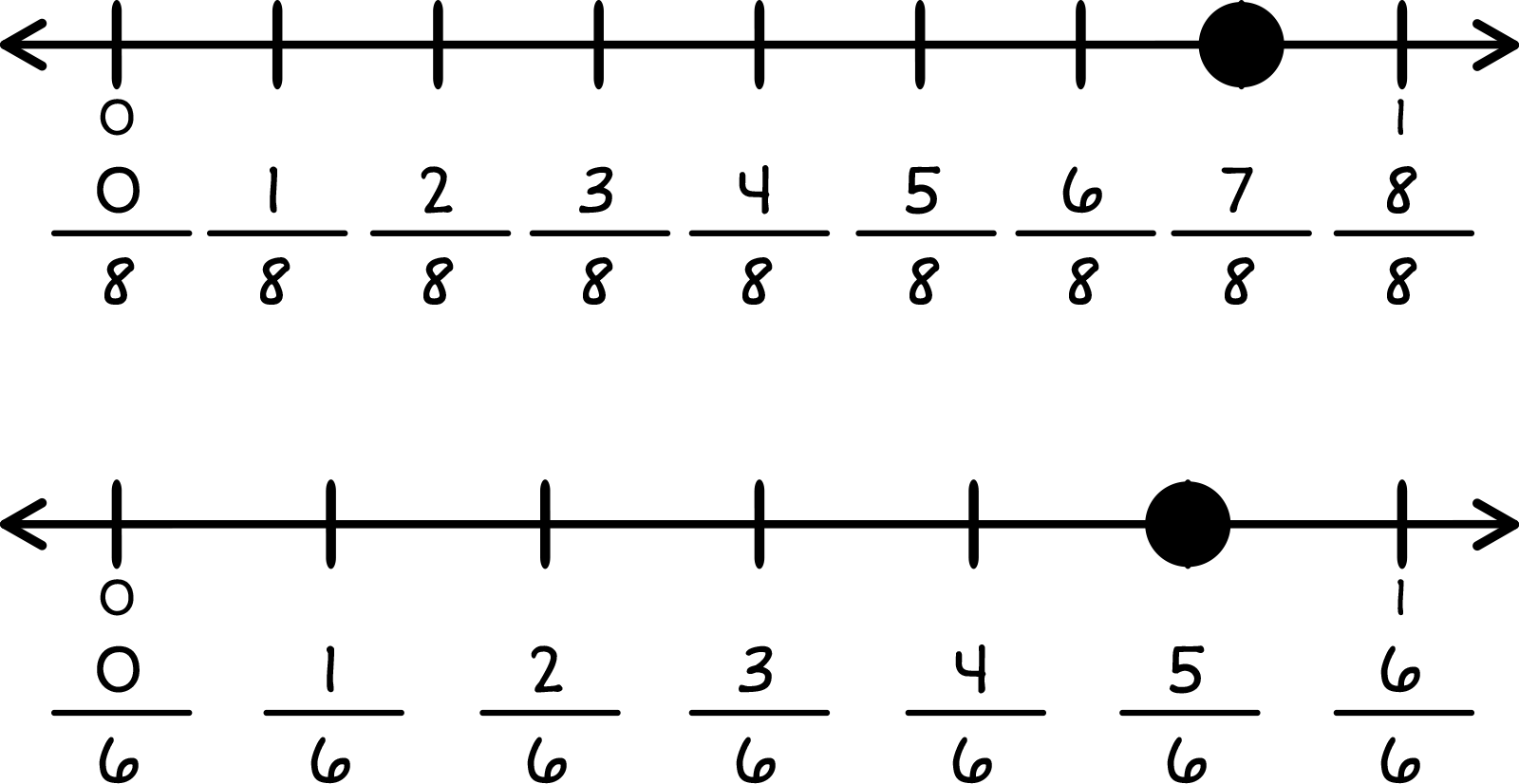
Top: Number line from 0 to 1 with 9 markers. Marks are labeled from \({ \frac{0}{8} }\) to \({ \frac{8}{8} }\). Dot above \({ \frac{7}{8} }\).
Bottom: Number line from 0 to 1 with 7 markers. Marks are labeled from \({ \frac{0}{6} }\) to \({ \frac{6}{6} }\). Dot above \({ \frac{5}{6} }\).
-
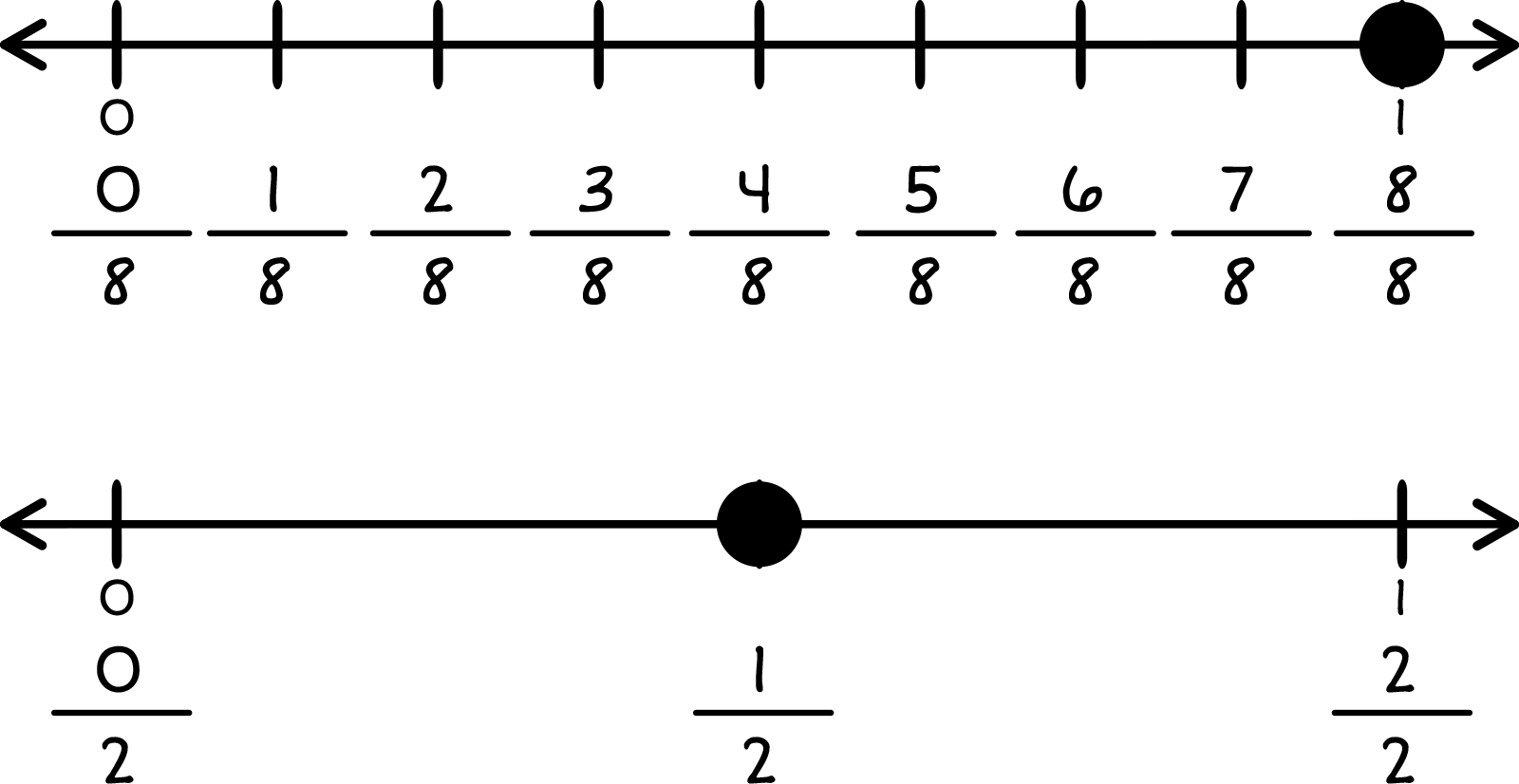
Top: Number line from 0 to 1 with 9 markers. Marks are labeled from \({ \frac{0}{8} }\) to \({ \frac{8}{8} }\). Dot above \({ \frac{8}{8} }\).
Bottom: Number line from 0 to 1 with 3 markers. Marks are labeled from \({ \frac{0}{2} }\) to \({ \frac{2}{2} }\). Dot above \({ \frac{1}{2} }\).
-

Top: Number line from 0 to 1 with 4 markers. Marks are labeled from \({ \frac{0}{3} }\) to \({ \frac{3}{3} }\). Dot above \({ \frac{1}{3} }\).
Bottom: Number line from 0 to 1 with 7 markers. Marks are labeled from \({ \frac{0}{6} }\) to \({ \frac{6}{6} }\). Dot above \({ \frac{4}{6} }\).
-
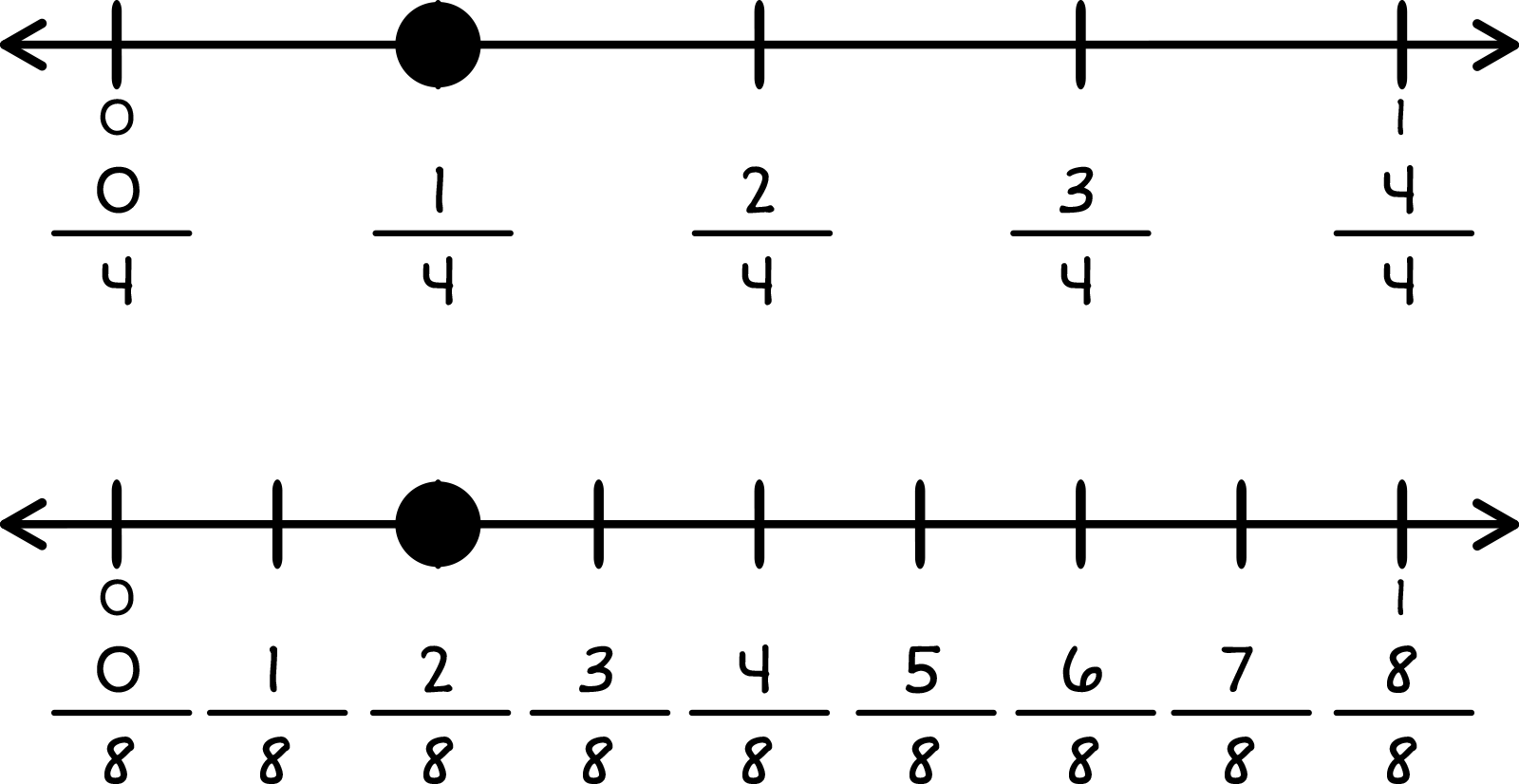
Top: Number line from 0 to 1 with 5 markers. Marks are labeled from \({ \frac{0}{4} }\) to \({ \frac{4}{4} }\). Dot above \({ \frac{1}{4} }\).
Bottom: Number line from 0 to 1 with 9 markers. Marks are labeled from \({ \frac{0}{8} }\) to \({ \frac{8}{8} }\). Dot above \({ \frac{2}{8} }\).
Sorry, these fractions are not equivalent because the dots do not line up on the number lines.
Sorry, these fractions are not equivalent because the dots do not line up on the number lines.
Sorry, these fractions are not equivalent because the dots do not line up on the number lines.
Yes! \({ \frac{1}{4} }\) and \({ \frac{2}{8} }\) are equivalent fractions because the dots line up on the number lines.
Which fraction is equivalent to \({ \frac{3}{6} }\)?

Number line from 0 to 1 with 7 markers. Marks are labeled from \({ \frac{0}{6} }\) to \({ \frac{6}{6} }\). Dot above \({ \frac{3}{6} }\).
-

Number line from 0 to 1 with 9 markers. Marks are labeled from \({ \frac{0}{8} }\) to \({ \frac{8}{8} }\). Dot above \({ \frac{4}{8} }\).
-

Number line from 0 to 1 with 5 markers. Marks are labeled from \({ \frac{0}{4} }\) to \({ \frac{4}{4} }\). Dot above \({ \frac{3}{4} }\).
-

Number line from 0 to 1 with 9 markers. Marks are labeled from \({ \frac{0}{8} }\) to \({ \frac{8}{8} }\). Dot above \({ \frac{2}{8} }\).
-

Number line from 0 to 1 with 3 markers. Marks are labeled from \({ \frac{0}{2} }\) to \({ \frac{2}{2} }\). Dot above \({ \frac{2}{2} }\).
Yes! \({ \frac{4}{8} }\) is equivalent to \({ \frac{3}{6} }\) because the dots line up.
Sorry, that is not correct. The dots on this number line do not line up with \({ \frac{3}{6} }\).
Sorry, that is not correct. The dots on this number line do not line up with \({ \frac{3}{6} }\).
Sorry, that is not correct. The dots on this number line do not line up with \({ \frac{3}{6} }\).
What are these equivalent fractions?

Left: Rectangle partitioned into 3 equal parts with 2 filled. Equals. Right: Rectangle partitioned into 6 equal parts with 4 filled in.
-
\({ \frac{0}{4} }\) \({ = }\) \({ \frac{2}{8} }\)
-
\({ \frac{2}{3} }\) \({ = }\) \({ \frac{4}{6} }\)
-
\({ \frac{2}{3} }\) \({ = }\) \({ \frac{3}{4} }\)
-
\({ \frac{2}{4} }\) \({ = }\) \({ \frac{7}{8} }\)
Sorry, that is not correct. These fractions show that \({ \frac{2}{4} }\) is equivalent to \({ \frac{4}{6} }\).
Yes! \({ \frac{2}{4} }\) is equivalent to \({ \frac{4}{6} }\).
Sorry, that is not correct. These fractions show that \({ \frac{2}{4} }\) is equivalent to \({ \frac{4}{6} }\).
Sorry, that is not correct. These fractions show that \({ \frac{2}{4} }\) is equivalent to \({ \frac{4}{6} }\).
Summary
Questions answered correctly:
Questions answered incorrectly:

